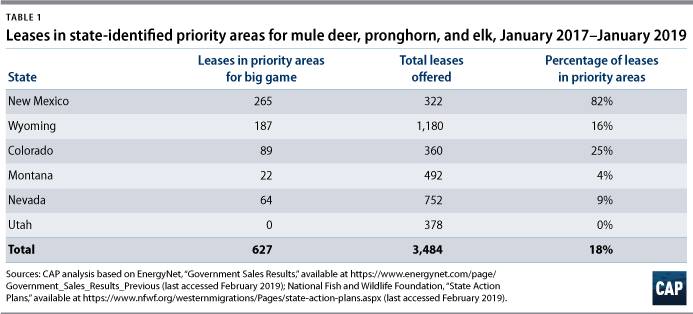On February 9, 2018, the U.S. Department of the Interior (DOI) released Secretarial Order 3362, a directive intended to align the department’s development priorities with the wildlife management and conservation needs of Western states. Now, just one year later, a Center for American Progress analysis reveals significant overlap of Western states’ priority habitats and recent U.S. Bureau of Land Management (BLM) oil and gas leasing.
The 2018 order centered around supporting key habitat for big game species such as elk, mule deer, and pronghorn, including by avoiding and minimizing development in critical winter ranges and migration corridors. The action was met with praise from sportsmen’s groups who applauded it as an important step in giving greater attention to big game habitats.
As a next step, the order required federal agencies to work with states to invest in habitat restoration and determine key areas where they should limit development detrimental to wildlife. States—which play an important role in managing wildlife— were invited to submit plans that explicitly identify priority areas for these three big game species in order to receive federal support for habitat restoration projects. The order tapped then-Deputy Secretary David Bernhardt to oversee the implementation.
Despite this undertaking, the new CAP analysis reveals how the BLM has shown disregard for the order’s goals, allowing oil and gas development in wildlife corridors. The most egregious example is New Mexico, where more than 80 percent of leases offered have been in areas identified by states as priorities for big game species. (see Table 1) This analysis raises questions about the DOI’s commitment to the letter and spirit of the secretarial order to improve big game wildlife habitat.
Oil and gas leasing in valuable habitats continues
Since the start of the Trump administration, the BLM has offered more than 3,400 oil and gas leases in the Intermountain West—nearly 1 in 5 of which has been in an area identified by the states as an important migration corridor or wintering grounds for elk, mule deer, or pronghorn. The proportion of oil and gas leases offered by the Trump administration in priority wildlife habitat has been particularly high in Colorado, New Mexico, and Wyoming, and, to a lesser degree, Nevada. In Montana and Utah, however, it does not appear that there are currently major conflicts with the locations of oil and gas resources and the priority areas identified by states.

Promoting oil and gas development in sensitive habitat can have severe consequences for both wildlife and Western state economies. Mounting evidence indicates it is detrimental to big game species in particular. For instance, in Wyoming, mule deer herds have declined by 40 percent over 15 years in regions where oil and gas extraction has boomed.
According to the U.S. Fish and Wildlife Service, 11.5 million Americans participate in hunting, spending more than $26 billion a year on the activity—a major revenue source for many states. In Colorado, New Mexico, and Wyoming, hunters spent a combined $400 million on hunting in 2016, which supported nearly 5,000 related jobs. But that revenue is based on healthy populations of pronghorn, mule deer, and elk—species whose habitats are threatened when oil and gas development is permitted.
Conclusion
Acting Secretary of the Interior David Bernhardt has referred to the DOI’s commitment to sportsmen frequently at events and on social media, calling the protection of migration corridors “a priority.” But despite the Trump administration’s pledge to protect big game migration corridors and wintering grounds, the department’s aggressive approach to oil and gas leasing threatens to undercut these efforts. As the U.S. Senate considers Bernhardt’s nomination to become the next secretary of the interior, the nominee should clarify whether this commitment to wildlife corridors will translate to real conservation measures or if it’s just a disingenuous attempt to win the support of sportsmen and conservation groups.
Ryan Richards is a senior policy analyst for Public Lands at the Center for American Progress. Jenny Rowland-Shea is a senior policy analyst for Public Lands at the Center. Mary Ellen Kustin is the director of policy for Public Lands at the Center.
The authors would like to thank Kate Kelly, Matt Lee-Ashley, Nicole Gentile, Chester Hawkins, and Shanée Simhoni for their contributions to this column.
Methodology
CAP’s analysis cross-walked the publicly available data on federal oil and gas lease sales with the state-identified wildlife priority areas where federal agencies should direct support pursuant to Secretarial Order 3362 to determine the extent to which the BLM’s oil and gas leasing programs conflict with the objectives of the order.
CAP’s analysis used data from oil and gas lease sales held from January 2017 through January 2019 in the states listed in the secretarial order that had more than five leases offered. The authors used lease sale data available in a geographic information system (GIS)-ready format through EnergyNet with the exception of the February 2017 sale in Wyoming and the September 2018 sale in Nevada, where available spatial data found on the BLM’s website was used. However, available spatial data for the September 2018 Nevada sale does not appear to cover all leases offered. Data on state priority areas were detailed in maps included in each state’s action plan. CAP used these maps to create a GIS layer demarcating the approximate boundaries of migration corridors, key wintering grounds, and priority study areas that states identified.
It is important to note that each state identified priorities using similar but not identical criteria. Some states provided spatial data depicting the movements of radio-collared animals or clearly mapped corridors, while others had more broadly defined priority regions. For example, Utah had larger regions identified as priorities for research on possible corridors, but instead of mapping known winter ranges in their entirety, it provided maps only for specific, small—less than 7,000 acres—habitat restoration projects its wildlife agency had planned. However, the authors considered these different areas to be of equal importance for this project, as they reflected the conservation goals of each state wildlife agency.